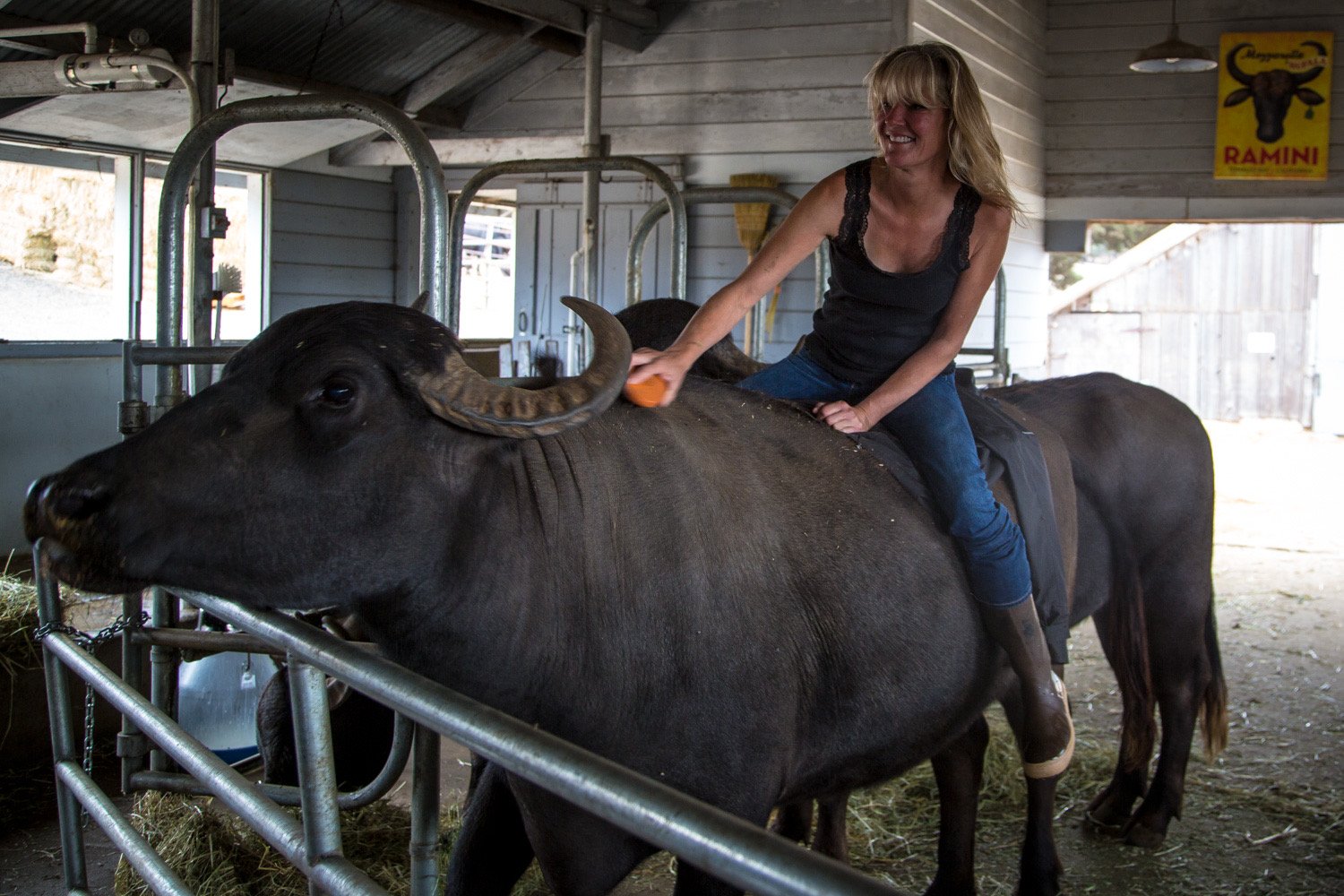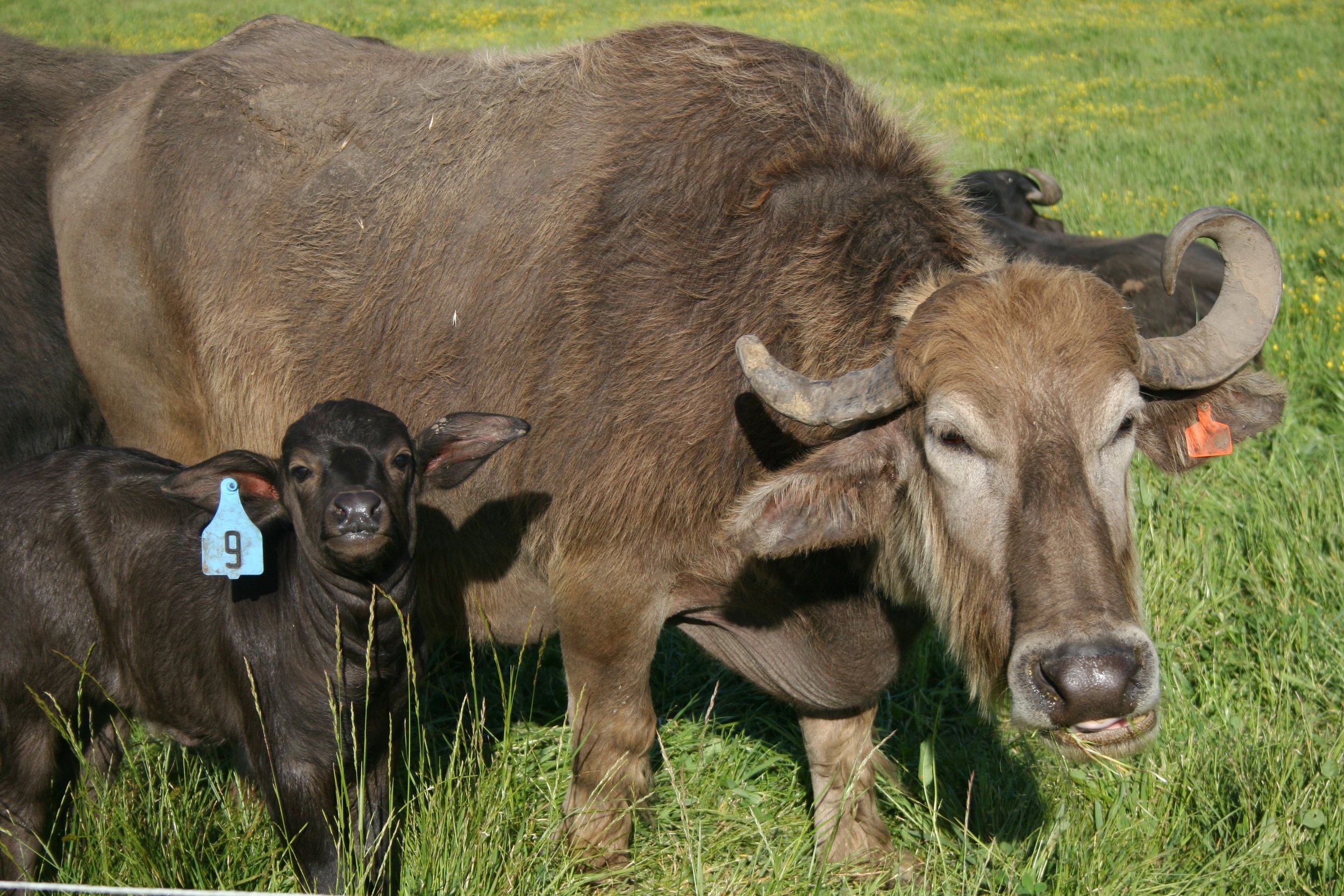How Love & Kindness Drives Animal Care at Ramini Mozzarella
On tours of Ramini Mozzarella in Tomales, California, owner Audrey Hitchcock animatedly recounts the story of the dairy’s founding in 2009, and the discovery that the bonds she and her husband, Craig Ramini, formed with their animals were not only the key to their success as a dairy, but provided them deep, affectionate relationships. In fact, Hitchcock asserts the water buffalo have loving dispositions. “If you give them love and kindness,” she says, “they will give it back and ask for more – just like dogs.”
Taming the Buffaloes
After the couple bought their first five water buffaloes, they realized that they were not yet tamed, and as herd animals and herbivores, they were instinctively afraid of two-legged animals, so they needed to be taught that the couple could be trusted. Ramini and Hitchcock had to come up with a solution on their own because they couldn’t find another water buffalo dairy that was still in business. It seemed that several large dairies, with over 100 animals each, had all been unsuccessful and closed. How were they going to tame their little troop?
While Audrey (who is also an architect) worked on plans to renovate their rented farm, Craig spent time every day the first year with their five water buffaloes. The big girls were afraid of him at first, but after a year of kind attention, they ran toward him and not away. The next step was to bring them into the barn and get down to the business of milking them (they had all recently had calves). This turned out not to be such a simple a task. Audrey describes what happened:
“The renovations were done, and it was time to get milk out of the mothers, Craig is inside the barn, and he is calling to them, ‘Come on girls, Daddy’s here, come on inside.’ They would walk up to the barn door, and they would want to see him because they love him, but they would look at the threshold and say ‘I can’t. There’s a threshold.’
They discovered the reason behind this seemingly perplexing behavior:
Says Hitchcock, “All bovines are instinctively afraid of thresholds and arches. They can’t cross a grate. They seem to suspect that it signals danger. In nature, it could be a change in ground level, like a creek or a fallen tree. So, their instinct is to go around it. But both of those conditions apply to all dairies, they have an entrance with changing ground level and an archway, and the water buffaloes have a mental block against going in. And if one has to force these very intelligent, large and stubborn animals to do something they can’t instinctively do, it will not be pleasant.”
But there is also something they love. “I call it cookies,” explains Hitchcock, “It’s an all-purpose livestock mix with molasses and oats, and they just love it. We put it in a bowl and shake it. So, Craig gets out the cookies, puts it in a bowl and shakes it, and says, come on girls, you come inside, and you get some cookies.”
Nothing Stronger Than Mother’s Love
Still, they had no luck coaxing the buffaloes, Hitchcock explains their resistance:
“It’s like they’re saying, ‘I love those cookies and I want some, but I can’t go inside, can you bring the cookies outside?’ We feel defeated, what are we going to do? We don’t want to beat them. After a few weeks of thinking, we realize there is one thing that the female water buffalo will do absolutely anything for: her calf. So that’s when we decided, this business of taking the calf away from the mother permanently [that most other dairies do] – Forget that! We’re going to maintain the relationship between the calf and the mother and we’re going to use the calf to pull the mother into the barn. So, every day at 4pm, we call the herd in, sift the babies into this separate corral we call “calf town” and then we release the mothers into the pasture. The mothers can maintain visual contact with their babies all night long. Then in the morning, we show up and the mother has a full udder, she’s at the gate and she wants her calf back.”
She goes on to explain, “We just reverse everything the other dairies had tried. We open the gate, let a couple of mothers in, then we take a couple of babies, put them on a halter, and walk them into the barn. The mother has seen her baby all night long, she sees it in the morning, everything is cool, then the baby disappears into the barn. Now we have created a sense of anxiety and unhappiness and fear. She’s like, ‘Oh my god, my calf has disappeared.’ So, we open up the gate and she runs--she FLIES--across the threshold. She doesn’t even think about the threshold. The only thing she thinks about is ‘I’ve got to get my eyes on my calf. I have to see my baby.’ Then she gets into the barn, and she sees her calf and this wave of happiness and relaxation overcomes her. She thinks ‘I can see my calf, so everything is going to be okay.’ Then we come in with positive reinforcement, we give her a bowl of cookies and she is, ‘Yes! I love these cookies! This is great!’ We do this every day for two weeks and it’s just routine. She’s like, ‘This is great, sign me up for going in to get my baby and getting cookies.’ After this becomes routine for them, we start applying the milking equipment. The baby is right there, she’s as happy as can be and we’re getting milk. As the milk pumps out for us, we are free to brush the mother, and play with the babies. When they’re done, we release the calves from halters, open up the end gate, and mother collects her baby, and they go out and spend the day in the pasture together.”
Another obstacle they faced was how to hold the water buffaloes in place while they are being milked. Typical dairy farms use stanchions, a contraption of vertical metal bars which squeeze a cow’s head, so it doesn’t move when you milk her. They tried that method and had the buffalo looking out at a window. But the girls didn’t like it.
Hitchcock proudly claims to be an “amateur anthropomorphizer,” (which means she can imagine herself in animals’ place and speak for them.) And she realized that if she were in the dairy barn, she would want to be looking at her calf instead out a window. So they switched the orientation of the mothers so they were gazing at their babies. It worked! And they didn’t need the uncomfortable stanchions.
At Ramini, they only milk their buffalo once a day, instead of the usual twice (which means they only get half as much milk to make cheese from). Audrey explains why:
“I could separate the babies and milk the mothers twice a day. I do not. Many reasons. I don’t want to milk two times a day/365 days a year. More importantly, there’s a lot of research about how important it is for the mother to raise and breast feed their calves. Important that they are raised by their mothers and learn from them. It’s documented that in the wild, the females stay with their mothers for life. So, the babies get to suckle for a second milking all day long.”
Getting Up Close & Personal
On the tour Hitchcock leads the tour-goers inside the barn to see where the water buffalo are milked plus a peek through the window at the creamery, then everyone returns to the outside tables now spread with a generous snack of fresh mozzarella, ricotta, and stracciatella. At the end of the afternoon, eager guests are encouraged to brush some patient calves, under the watchful eyes of their mothers in another pen, because love and kindness she describes on the tour is best experienced in person.



